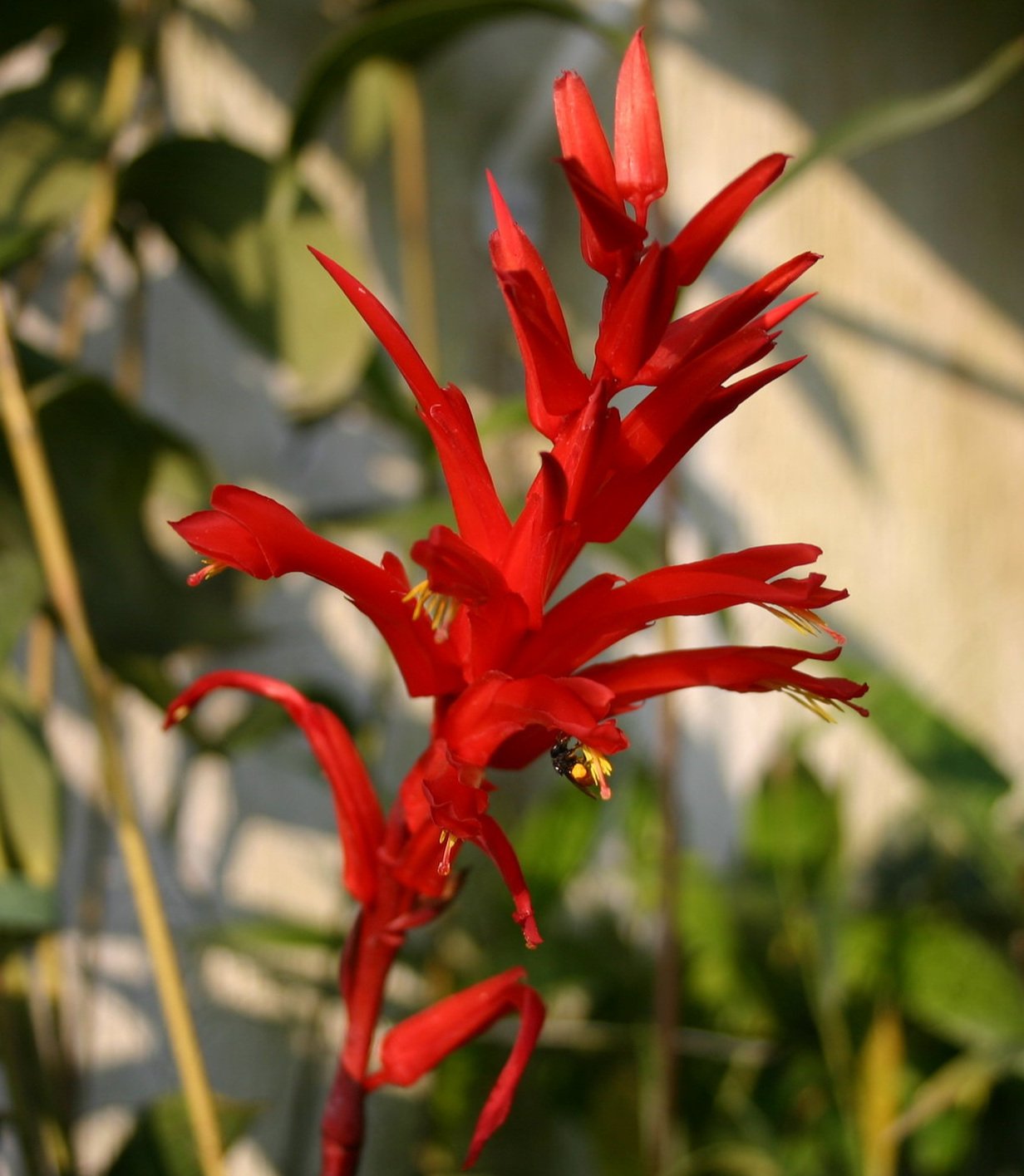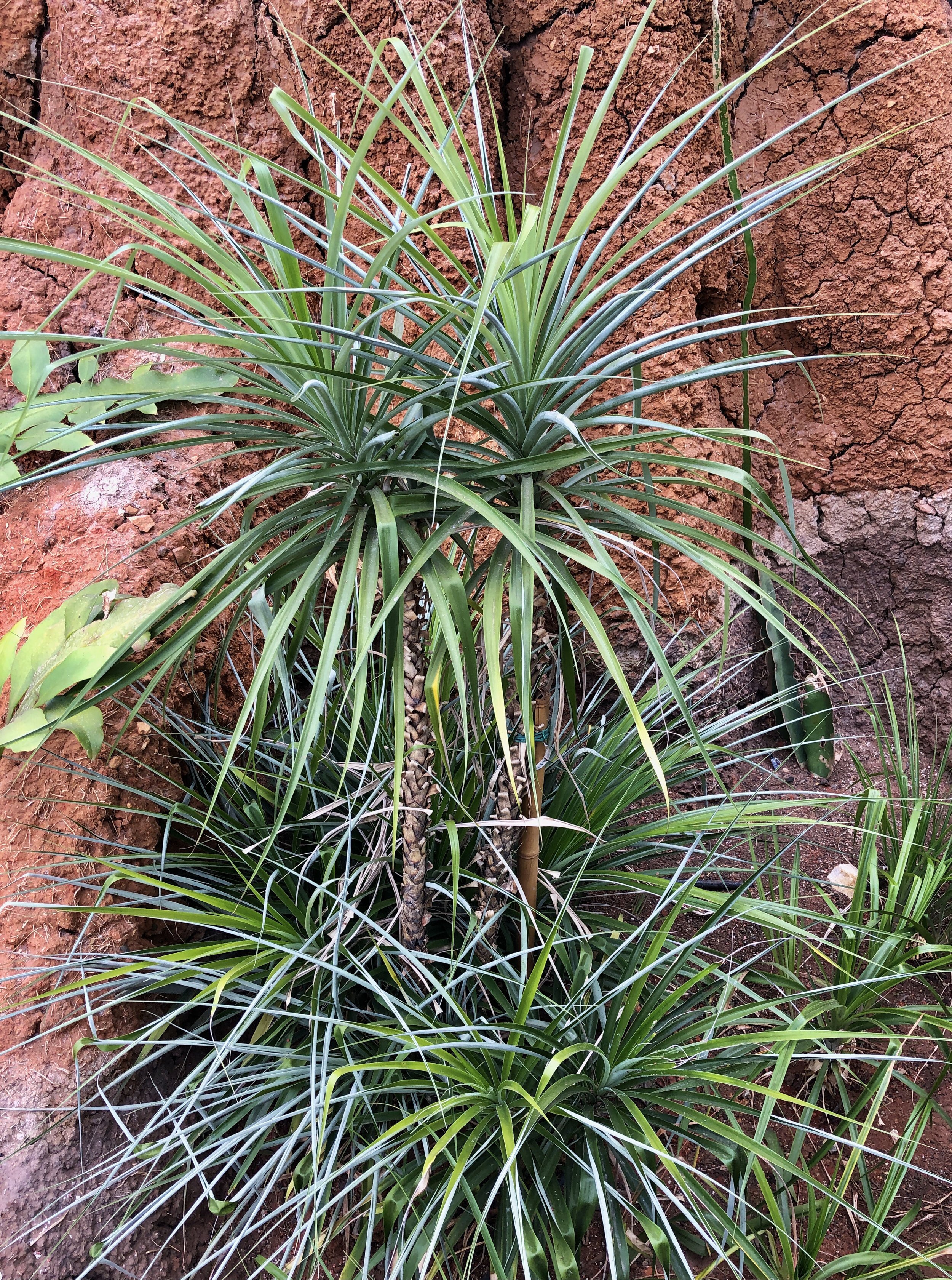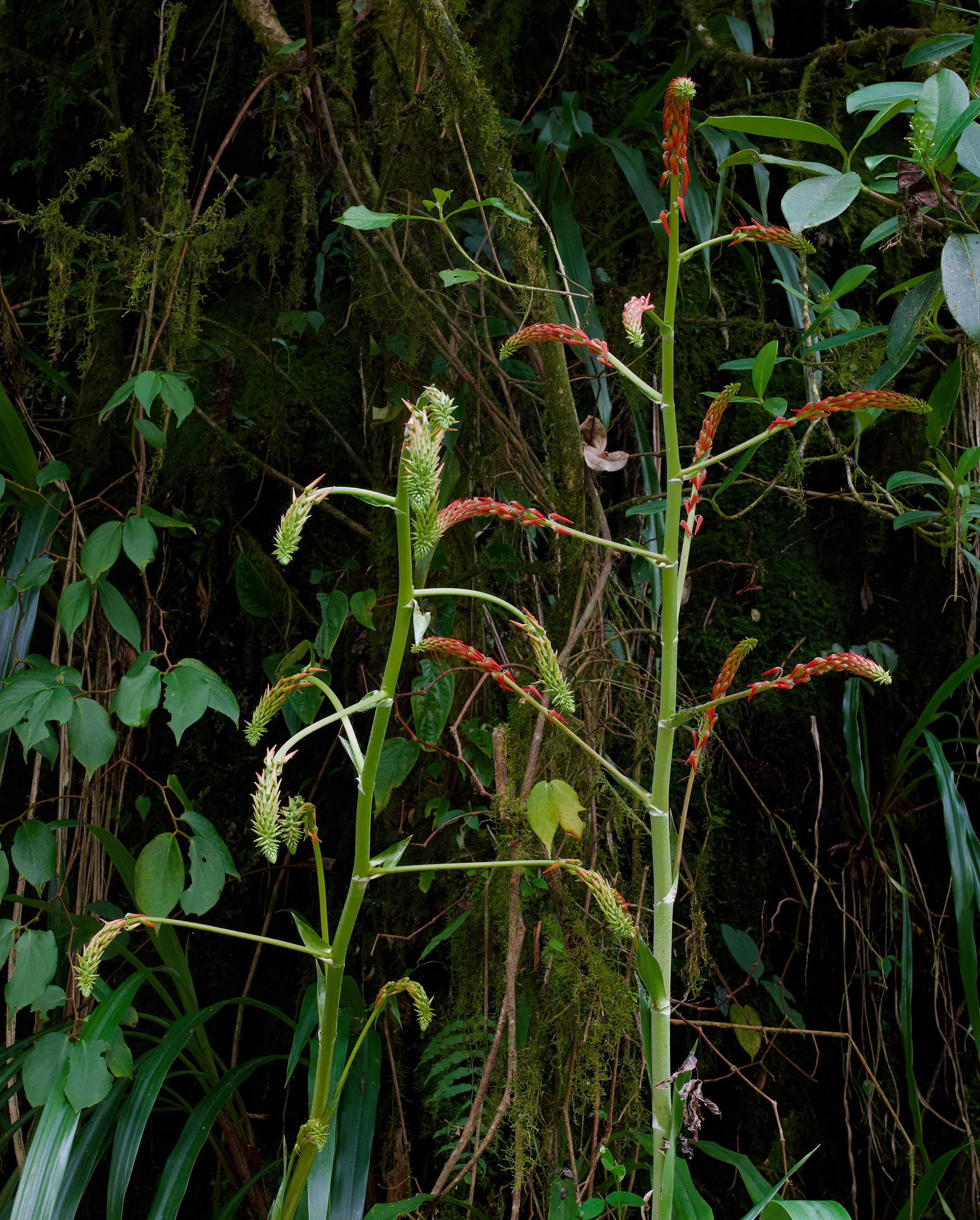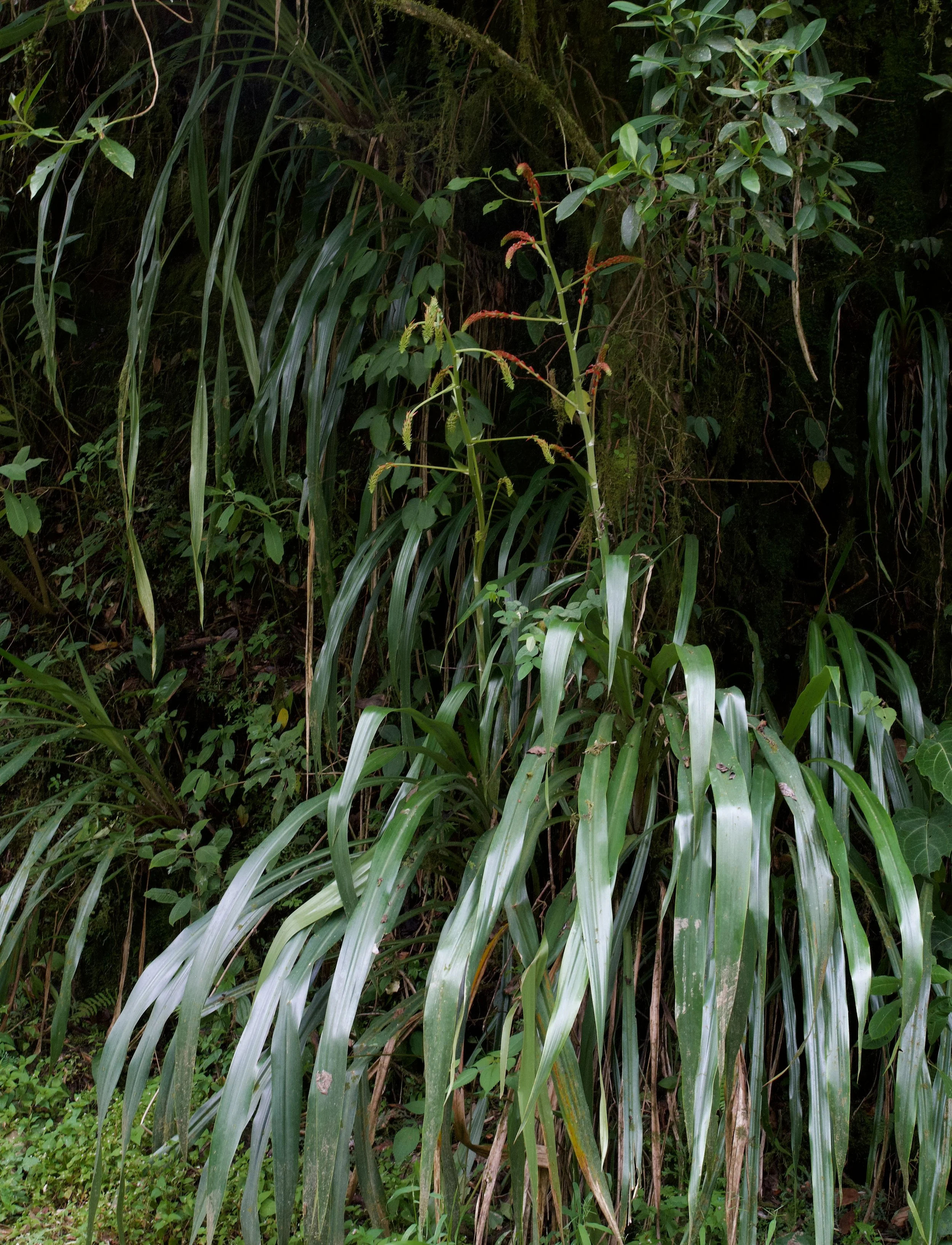They're the Pits
by Jay Vannini
Colonial Pitcairnia sp. aff. ringens growing as lithophytes, upper montane wet forest, Sierra de las Minas, Guatemala. True P. ringens can also be found growing as an epiphyte in parts of its southeast Mexican range. Image: ©F. Muller.
The Guiana Shield endemic, Pitcairnia pruinosa, flowering on the edges of small, seasonal pools on ancient granite outcrops in lowland tropical rainforest in Vichada Department, Colombia. ©Jay Vannini.
The fabulous inflorescences on the Peruvian Amazon Pitcairnia pseudoundulata. The broad, red-striped leaves on this 3’/95 cm tall species are very attractive as well. Image: ©Jay Vannini.
Pitcairnias are a very diverse group of bromeliads that are woefully under-represented in plant collections and tropical gardens. It is the second largest genus of bromeliads after Tillandsia and lends its name to subfamily Pitcairnioideae. This is a somewhat unwieldy and certainly under-described genus with ~470 species and subspecies currently accepted by botanists (Saraiva et al., 2015; Encyclopedia of Bromeliads, 2018). Like many species-diverse plant groups with wide ranges across the Neotropics, current numbers may fail to reflect just how speciose this genus really is. Relatively few forms–certainly under a dozen– are popular in cultivation, mostly due to a general lack of availability and the widespread belief that pitcairnias are just nondescript, spiny plants with grassy leaves and boring flowers. However, as I will show here there are many beautiful and manageable species that include some forms that exhibit both handsome foliage and very colorful inflorescences.
The mostly showy-flowered genus Pepinia has been sunk into synonymy and is now generally regarded as a subgenus, but there are some oddball Pitcairnia species that may warrant being segregated in separate genera the future.
I currently grow about 35 species of pitcairnias in California, together with another half dozen forms left behind in Guatemala and am familiar with many more in nature across most of their range. As pot plants they are generally easily grown, although there are a few occasionally tricky deciduous ones such as Pitcairnia tabuliformis and few others that require a fairly lengthy dry rest when dormant. The majority of species in this genus have bright yellow, orange or red floral bracts and corollas. While the flowers proper are, like most bromeliads short-lived, the conspicuous floral bracts on the inflorescences of some species may remain in good color for up to two months.
Shown above are two color shades of the compact southeastern Brazilian endemic, Pitcairnia burle-marxii, growing in the author’s collections in California and Guatemala. This is another species with attractive foliage and a small colony can be grown to maturity in an 8”/20 cm bulb pan. Images: ©Jay Vannini.
Above left, the white-flowered Pitcairnia maidifolia in nature, Valle del Cauca Department, Colombia. Image: ©F. Muller. Upper right, an Ecuadoran cloud forest form of the widespread and very attractive P. nigra, showing black-tipped corollas. The inflorescence of this species can hold bright color from early development through to the last spent flowers for up to three months. Author’s collection and image.
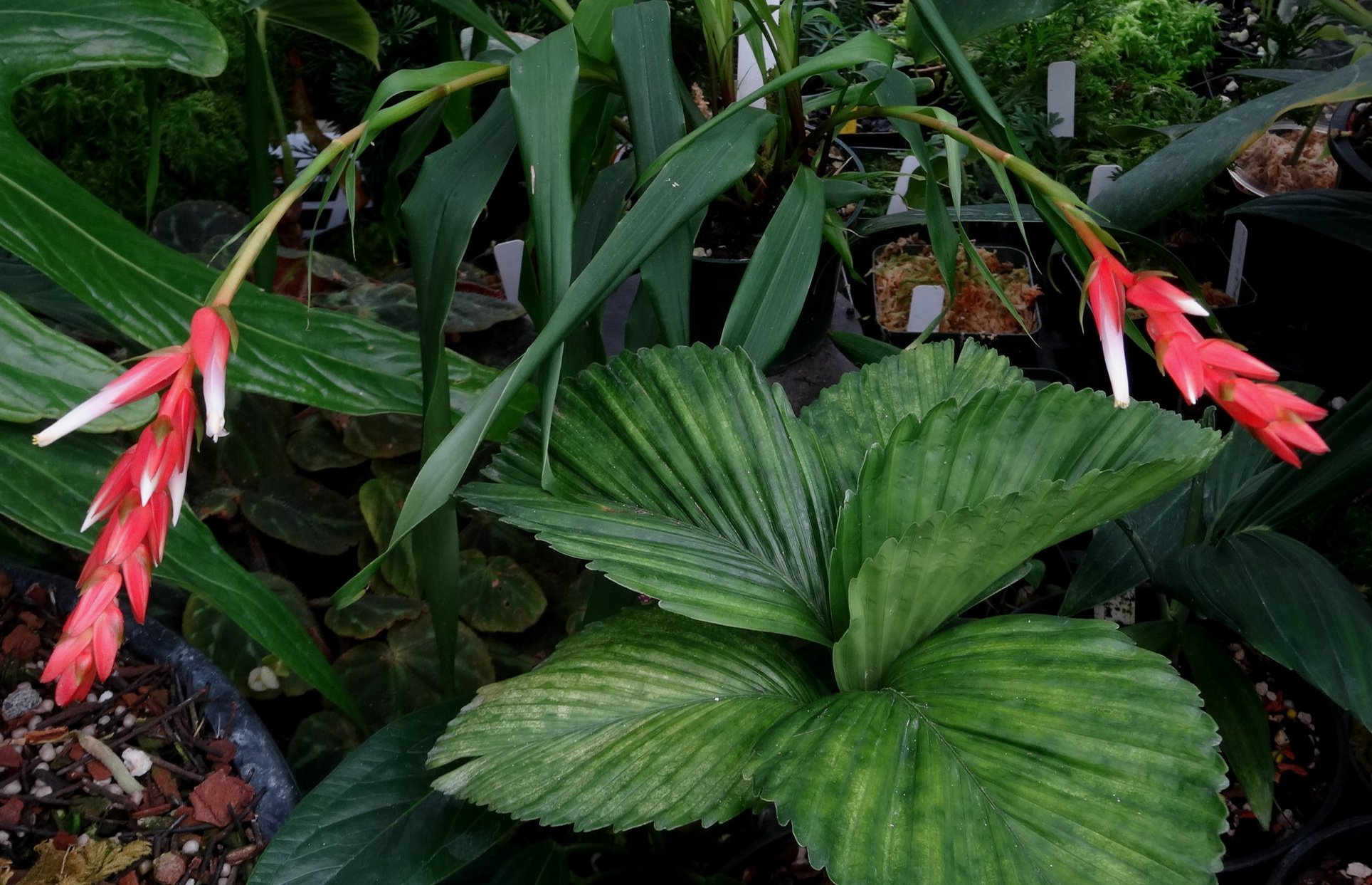
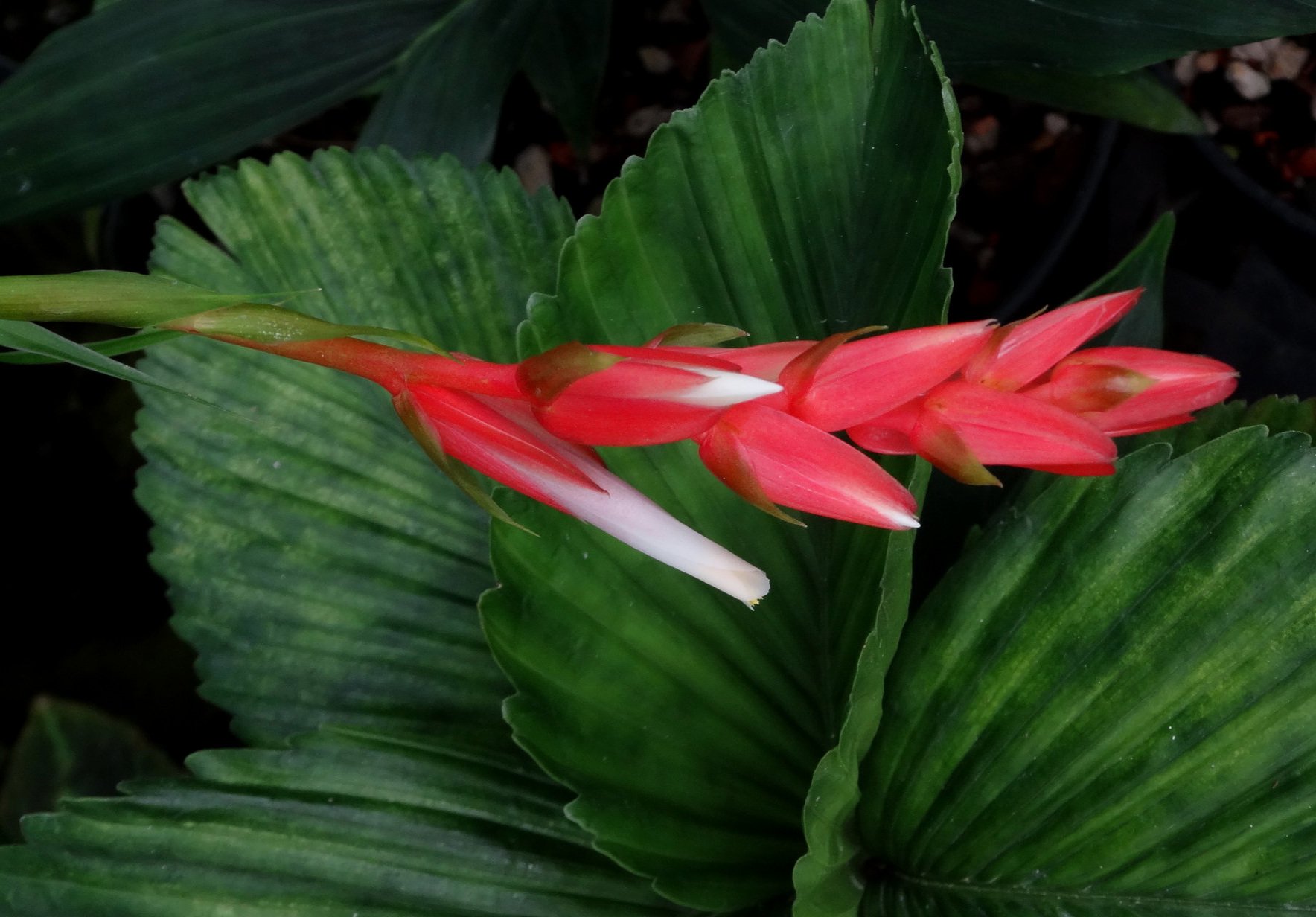
Above, the enigmatic dwarf Pitcairnia heerdeae from Cundinamarca Department in central Colombia growing in my collection in California. Described by Elvira Gross and Werner Rauh in 1990 based on a single accession from an anonymous, presumably Dutch, collector. This is one of the most desirable of all the miniature pitcairnias and can be grown to flowering size in a 4”/10 cm pot as shown here. Although the exact locality remains a bit of a mystery, it does well under cool, humid greenhouse conditions. Images are rare and it appears to be very poorly distributed in bromeliad collections or public gardens outside of northern Europe. The pure white corollas are a particularly nice touch. Bract morphology and and habit are somewhat reminiscent of both the Peruvian P. sprucei, shown below and the Brazilian P. burle-marxii shown above. Images: ©Jay Vannini.
A rarely seen southeastern Mexican rainforest species, Pitcairnia ocotensis, undercanopy in nature. Image: ©F. Muller.
Mature inflorescence of the southern Ecuadoran rarity, Pitcairnia andreetae. Author’s collection.
This species highlights the fact that are both pure white (e.g. Pitcairnia albiflos, P. heerdeae) to genuine black corollas (P. andreeteae and P. rubronigriflora) as well as those possessing bicolored flowers (e.g., P. nigra, P. hitchockiana) represented in the genus. Several have both red and white or yellow-flowered forms within given populations (e.g., P. heterophylla and P. bifrons). The southeastern Ecuadoran rarity and narrow endemic, P. andreetae, may lay claim to having the “blackest” flowers and bracts of all known plant species. As many gardeners know, most “black” blooms advertised as such are either dark brown (e.g., Alcea rosea f. nigra - Malvaceae), very deep violet (Lisianthus nigrescens - Gentianaceae) or complex hybrids (xFredclarkeara - Orchideaceae). As is evident in the images shown here, the floral bracts and flowers of this remarkable species of Pitcairnia are a very saturated true black.
The eastern Mexican Pitcairnia ringens, effectively utilized as a visual anchor in the landscape in a wooded San Francisco Bay Area garden. Author’s collection and image.
Shown above, “true” Pitcarnia flammea var. glabrior from rocky outcrops in lowland forest remnants of coastal Paraná and Rio de Janeiro states in southeastern Brazil. This is a seed-grown plant flowering on my terrace in California in early November. This plant has been subjected to multiple winters outdoors and has experienced temperatures below 32 degrees F/0 C with little damage to the leaves. It puts on a beautiful–if rather short-lived–display when in full flower. Besides its beautiful inflorescences it has the added attraction of being spineless, with lax rather succulent leaves. Authors collection and images.
The miniature Ecuadoran lithophyte, Pitcairnia condorensis, fully mature and offsetting vigorously in a 5”/12.5 cm pot. Author’s collection and image.
Based on outdoor trials I have done in the San Francisco Bay Area with a handful of species as well as from comments made by others, there appear to be many species of highland Mexican, Andean and Brazilian pitcairnias that can tolerate temperatures near freezing with little or no visible damage. All of these species are worth trialing in Mediterranean and dry subtropical climate zones. It is important to establish plants intended for outdoor displays in media that is durable and very free-draining, and to provide some light overhead protection for more valuable plants until it is determined that they can adapt to your local winter rainfall regimen.
One extralimital species, Pitcairnia feliciana, is an endangered, localized, small lithophytic species with pale orange corollas that is restricted to sandstone cliffs in southwestern Guinea in tropical Africa. Molecular work indicates this west African species is (unsurprisingly) closely related to Atlantic forest Brazilian forms. Chance intercontinental dissemination by migrating birds seems a likely origin and would explain its very localized distribution on the opposite side of the tropical Atlantic. Despite its unique Old World distribution among the bromeliads, surprisingly little interest has been shown by growers and botanical gardens to bring this rare species into cultivation.
Shown above the popular and unusual-looking north Chiapan endemic, Pitcairnia tabuliformis, a lithophyte with deciduous, succulent leaves and a nested inflorescence usually found growing on banks or cliffs above rivers and streams in the region. Shown upper left in nature, image ©F. Muller. Image upper right from the author’s collection.
The stunning Peruvian Amazon spineless, compact Pitcairnia sprucei in flower during mid-summer in California. Like its larger relative, P. pseudoundulata, both foliage and inflorescences in this plant are beautiful. Another clone I grow has even brighter and broader red mid stripes on its leaves. Somewhat cool temperature tolerant despite its tropical rainforest origins, but will be severely damaged or die if left to overwinter outside in the San Francisco Bay Area. Image: ©Jay Vannini.
Most Pitcairnia species are terrestrial or lithophytic, but a good number are also epiphytic, hemiepiphytic or rheophytic. Many of the strictly epiphytic types launch long, scaly stolons from the bases of older plants and develop new rosettes as “satellites” that may either creep along branches or hang suspended in mid-air. Fine marginal spines–often needle sharp and brittle–are usually concentrated along the basal portions of the leaves.
Pitcairnia dolichopetala in Tropical Pluvial Forest, Valle del Cauca Department, Colombia. Image: ©F. Muller.
Centers of diversity and endemism for the genus are in the Guyana Shield countries of northern South America (that is believed to be a major dispersal center), the cloud forests of the northwestern Andes of Ecuador and Perú, the Greater Chocó floral region from southern Costa Rica, through Panamá to southwestern Colombia, and the Atlantic Forest and Cerrado ecosystems of eastern Brazil. Southeastern México, especially the region where Oaxaca, Chiapas and Tabasco converge, also houses a fair number of species (>20).
Older species in cultivation include Pitcarnia flammea, P. corallina, P. tabuliformis, P. ringens, P. sanguinea, P. funckiae, P. imbricata, P. andreana and P. heterophylla. Some hybridization has been done within the genus, including one exceptional form created by the famed California bromeliad breeder John Arden (d. 2015); P. ‘Flaming Arrow’ (P. pseudoundulata x burle-marxii).
Several easily-grown Pitcairnia species with showy inflorescences in the author’s collection in California. Clockwise from top left: P. cataractae, P. decidua, P. atrorubens and P. hitchcockiana. All images: ©Jay Vannini
Pitcairnia palmoides, a hemiepiphytic species from the Amazonian foothill forests of eastern Ecuador and northeastern Perú. Author’s collection and image.
A few Pitcairnia species, especially P. funkiae and P. hitcockiana, have been grown on a limited scale for cut flower production in both Queensland, Australia and New Zealand. They have also been trialed (unsuccessfully) as houseplants in Holland. There are a few attractively-flowered miniature species such as P. heerdeae and P. sp. “Condor” that can flower in 4”/10 cm pots.
Mottled and spotted foliage may be found in rarely cultivated species such as Pitcairnia palmioides and P. brogniartiana.
As mentioned earlier, Pitcairnia species can make for excellent garden subjects in both warm subtropical and fully tropical conditions. The smaller epiphytic species may be grown mounted or in hanging baskets as indoor plants. Most growers find that the most commonly-cultivated species can be grown to flowering size in 8-12”/20-30 cm pots, but there are some large species (e.g. P. imbricata) that are best grown in tubs or as as bedding plants in warm subtropical gardens.
The spectacular southern Ecuadoran Pitcairnia bergii growing fully exposed on a wall planting in the author’s Guatemalan garden. This is an exceptionally desirable small species suitable for pot culture.
I grow the strictly epiphytic species like Pitcairnia alata and P. andreetae in a warm greenhouse potted in pure New Zealand sphagnum moss in 6”-8”/15-20 cm plastic hanging baskets to best display their inflorescences. Large terrestrials grow well in traditional bark mixes, especially in blends that incorporate small amounts of sphagnum peat or well-composted oak leaf litter to maintain soil acidity. Fine and medium grade conifer bark blends together with equal parts of pumice or medium perlite have proven suitable and very durable media to succeed with these plants.
Two relatively small terrestrial and lithophytic Pitcairnia species from Central America. Upper left, a rather aberrant unidentified Pitcairnia species, locality undisclosed. Image: ©F. Muller, Upper right, pink-flowered form of the widespread P. heterophylla that also has pure white a bright red flower color forms. Author’s collection and images.
Above, the extraordinary arborescent Pitcarnia huilensis (Betancur & Jiménez-Escobar 2015) from dry forests in the upper Río Magdalena Valley of Colombia. This dracaena-like bromeliad species grows to at least 5’/1.60 m tall. Shown on display and in flower at the Tropicario in the Bogotá Botanical Garden. Images: ©Jay Vannini.
While working with the smaller species is usually pain-free, dividing some of the larger pitcairnias can be a challenge so I try to avoid letting plants get too crowded. Since the everyday exigencies of life dictate that I am always behind on repotting, I am usually faced with having to saw my way through masses of spiny basal bulbs when repotting become a must. A very sharp kitchen knife, heavy duty pruners, bonsai saws and GLOVES are useful things to have at hand when dividing pot-bound examples of the larger terrestrial and lithophytic forms.
Two closely-related stoloniferous and epiphytic Ecuadoran Pitcairnia species with very different-colored flowers; P. andreetae (upper left) and P. cf. alata (right). As seen here, both may be grown to specimen size in 6”/15 cm hanging pots or baskets. Author’s collection.
This is a bromeliad genus with many remarkable and beautiful species worthy of a wider audience among exotic plant collectors. As nurseries in the Andean countries gradually expand their offerings of unusual bromeliads, and EU and U.S. botanical gardens slowly release excess inventory from their collections housed on off-exhibit benches, I expect a far wider range of Pitcairnia species will find their way into ornamental horticulture.
A giant terrestrial Pitcairnia sp. coming into flower in upper elevation cloud forest in Risaralda Department, Colombia. This remarkable species has inflorescences that resemble thorny-headed worms (acanthocephalans). Likely one of the largest members of the genus, the plant shown was ca. 6’/1.85 m tall, but other less photogenic examples reached almost 7’/2.15 m tall. Images: ©Jay Vannini.
Pitcairnia imbricata in nature, Cortés Department, Honduras. Image: ©F. Muller.
A tall form of Pitcairnia dodsonii from northern Perú flowering in the author’s California collection. Image: ©Jay Vannini.



